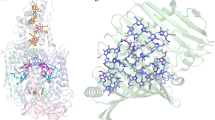Abstract
Bioluminescence spectra of the wild-type recombinant Luciola mingrelica firefly luciferase and its mutant form with the His433Tyr point mutation were obtained within the pH 5.6–10.2 interval. The spectra are shown to be a superposition of the spectra of the three forms of the electronically excited reaction product oxyluciferin: ketone (λmax = 618 nm), enol (λmax = 587 nm), and enolate-ion (λmax = 556 nm). The shift in λmax by 40 nm to the red region in the mutant luciferase bioluminescence at the pH optimum of enzyme activity (pH 7.8) is explained by the change in the relative content of different oxyluciferin forms due to the shift in the ketone ↔ enol ↔ enolate equilibria. A computer model of the luciferase-oxyluciferin-AMP complex was constructed and the structure of amino acid residues participating in the equilibrium is proposed. Computer models of the protein region near the His433 residue for the wild type and mutant luciferases are also proposed. Comparison of the models shows that the His433Tyr mutation increases flexibility of the polypeptide loop that binds the N and C domains of luciferase. As a result, the flexibility of the C domain amino acid residues in the emitter microenvironment increases, and this increase may be the reason for the observed differences in the bioluminescence spectra of the native and mutant luciferases.
Similar content being viewed by others
REFERENCES
McElroy, W. D., and De Luca, M. (1974) in Chemiluminescence and Bioluminescence (Cormier, M. J., Hercules, D. M., and Lee, J., eds.) Plenum Press, New York, pp. 285–311.
Seliger, H. H., and McElroy, W. D. (1964) Proc. Natl. Acad. Sci. USA, 52, 75–81.
Wood, K. V., Lam, Y. A., Seliger, H. H., and McElroy, W. D. (1989) Science, 244, 700–702.
Ugarova, N. N. (1989) J. Biolum. Chemilum., 4, 406–418.
Viviani, V. R., Silva, A. C. R., Perez, G. L. O., Santelli, R. V., Bechara, E. J., and Reinach, F. C. (1999) Photochem. Photobiol., 70, 254–260.
Gandelman, O. A., Brovko, L. Yu., Ugarova, N. N., Chikishev, A. Yu., and Shkurinov, A. P. (1993) J. Photochem. Photobiol., B: Biol., 19, 187–191.
Kricka, L. J. (2000) in Methods in Enzymology. Bioluminescence and Chemiluminescence, Vol. 305 (Ziegler, M. M., and Baldwin, T. O., eds.) Academic Press, San Diego, pp. 333–345.
Ohkuma, H., Abe, K., Kosaka, Y., and Maeda, M. (2000) Luminescence, 15, 21–27.
Ugarova, N. N. (1993) Appl. Biochem. Microbiol. (Moscow), 29, 135–144.
Ugarova, N. N., and Brovko, L. Yu. (2002) Luminescence, 17, 321–330.
White, E. H., Rapaport, E., Hopkins, T. A., and Seliger, H. H. (1969) J. Am. Chem. Soc., 91, 2178–2180.
Ueda, H., Yamanouchi, H., Kitayama, A., Inoue, K., Hirano, T., Suzuki, E., Nagamune, T., and Ohmiya, Y. (1997) in Bioluminescence and Chemiluminescence. Molecular Reporting with Photons (Hastings, J. W., Kricka, L. J., and Stanley, P. E., eds.) John Wiley, Chichester, pp. 216–219.
Ohmiya, Y., Ohba, N., Toh, H., and Tsui, F. I. (1995) Photochem. Photobiol., 62, 309–313.
Branchini, B. R., Magyar, R. A., Murtiashaw, M. H., Anderson, S. M., Helgerson, L. C., and Zimmer, M. (1999) Biochemistry, 38, 13223–13230.
Lundovskich, I. A., Leontieva, O. V., Dementieva, E. I., and Ugarova, N. N. (1999) in Bioluminescence and Chemiluminescence. Perspectives for 21st Century (Roda, A., Pazzagli, M., Kricka, L. J., and Stanley, P. E., eds.) John Wiley, Chichester, pp. 420–424.
Weiner, S. J., Kollman, P. A., Case, D. A., Singh, U. C., Ghio, C., Alagona, G., Profeta, S. Jr., and Weiner, P. (1984) J. Am. Chem. Soc., 106, 765–784.
Weiner, S. J., Kollman, P. A., Nguyen, D. T., and Case, D. A. (1986) J. Comp. Chem., 7, 230–252.
Sandalova, T. P., and Ugarova, N. N. (1999) Biochemistry (Moscow), 64, 962–967.
Minkin, V. I., Simkin, B. F., and Minyaev, R. M. (1997) Theory of Molecular Structure [in Russian], Feniks, Rostov-on-Don.
Conti, E., Franks, N. P., and Brick, P. (1996) Structure, 4, 287–298.
Conti, E., Stachelhaus, T., Marahiel, M. A., and Brick, P. (1997) EMBO J., 16, 4174–4183.
Zako, T., Ayabe, K., Aburatani, T., Kamiya, N., Kitayama, A., Ueda, H., and Nagamune, T. (2003) Biochim. Biophys. Acta, Proteins & Proteomic, 1649, 183–189.
Author information
Authors and Affiliations
Corresponding author
Additional information
__________
Translated from Biokhimiya, Vol. 70, No. 11, 2005, pp. 1534–1540.
Original Russian Text Copyright © 2005 by Ugarova, Maloshenok, Uporov, Koksharov.
Rights and permissions
About this article
Cite this article
Ugarova, N.N., Maloshenok, L.G., Uporov, I.V. et al. Bioluminescence Spectra of Native and Mutant Firefly Luciferases as a Function of pH. Biochemistry (Moscow) 70, 1262–1267 (2005). https://doi.org/10.1007/s10541-005-0257-2
Received:
Revised:
Issue Date:
DOI: https://doi.org/10.1007/s10541-005-0257-2




